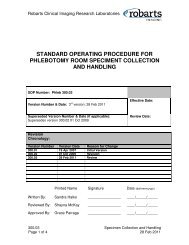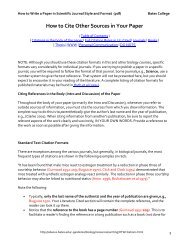Ten Secrets to Giving a Good Scientific Talk.pdf - Robarts Imaging
Ten Secrets to Giving a Good Scientific Talk.pdf - Robarts Imaging
Ten Secrets to Giving a Good Scientific Talk.pdf - Robarts Imaging
You also want an ePaper? Increase the reach of your titles
YUMPU automatically turns print PDFs into web optimized ePapers that Google loves.
<strong>Ten</strong> <strong>Secrets</strong> <strong>to</strong> <strong>Giving</strong> a <strong>Good</strong> <strong>Scientific</strong> <strong>Talk</strong><br />
More people will probably listen <strong>to</strong> your scientific talk than will read the paper you may write.<br />
Thus the scientific talk has become one of the most important communication forums for the<br />
scientific community. As proof, we need only look at the rising attendance at and the<br />
proliferation of meetings. In many ways your research reputation will be enhanced (or<br />
diminished) by your scientific talk. The scientific talk, like the scientific paper, is part of the<br />
scientific communication process. The modern scientist must be able <strong>to</strong> deliver a well organized,<br />
well delivered scientific talk<br />
I have compiled this personal list of "<strong>Secrets</strong>" from listening <strong>to</strong> effective and ineffective<br />
speakers. I don't pretend that this list is comprehensive - I am sure there are things I have left out.<br />
But, my list probably covers about 90% of what you need <strong>to</strong> know and do.<br />
Most scientific presentations use visual aids - and almost all scientific presentations are casual<br />
and extemporaneous 1 . This "scientific style" places some additional burdens on the speaker<br />
because the speaker must both manipulate visual media, project the aura of being at ease with the<br />
material, and still have the presence <strong>to</strong> answer unanticipated questions. No one would argue with<br />
the fact that an unprepared, sloppy talk is a waste of both the speaker's and audience's time. I<br />
would go further. A poorly prepared talk makes a statement that the speaker does not care about<br />
the audience and perhaps does not care much about his subject.<br />
So what are the secrets of a good talk? Here is my list of do's and don'ts.<br />
1) Prepare your material carefully and logically. Tell a s<strong>to</strong>ry. The s<strong>to</strong>ry should have four<br />
parts:<br />
(a)Introduction (b) Method (c) Results (d) Conclusion/Summary.<br />
The Introduction should not just be a statement of the problem - but it should indicate your<br />
motivation <strong>to</strong> solve the problem, and you must also motivate the audience <strong>to</strong> be interested in<br />
your problem. In other words, the speaker must try and convince the audience that the problem is<br />
important <strong>to</strong> them as well as the speaker.<br />
The Method includes your approach and the caveats. To me , the Method becomes more<br />
interesting <strong>to</strong> the listener if this section is "s<strong>to</strong>ry like" rather than "text book like". In other words<br />
"I did this and then I did that, but that didn't work so I did something else." This Rather than,<br />
"The final result was obtained using this approach." This adds the human element <strong>to</strong> your<br />
research which is always interesting.<br />
The Results section is a brief summary of your main results. Try and be as clear as possible in<br />
explaining your results - include only the most salient details. Less salient details will emerge as<br />
people ask questions.
The Conclusion/Summary section should condense your results and implications. This should be<br />
brief - a bullet or outline form is especially helpful. Be sure <strong>to</strong> connect your results with the<br />
overview statements in the Introduction. Don't have <strong>to</strong>o many points - three or four is usually the<br />
maximum.<br />
These four items are the core of a good talk. <strong>Good</strong> speakers often broaden the Introduction <strong>to</strong> set<br />
the problem within a very wide context. <strong>Good</strong> speakers may also add fifth item: Future<br />
Research.<br />
There is a crusty old saying among good speakers that describes a presentation from the<br />
communication viewpoint: "Tell'em what you are going <strong>to</strong> tell'em. Tell'em. Then tell'em<br />
what you <strong>to</strong>ld'em." The point of this aphorism is people absorb very little information at first<br />
exposure - multiple exposures are the best way for ideas <strong>to</strong> sink in. Thus, it is ok <strong>to</strong> state some of<br />
your results in the introduction, and then <strong>to</strong> repeat your main points in the results/ conclusion<br />
sections.<br />
2) Practice your talk. There is no excuse for this lack of preparation. The best way <strong>to</strong><br />
familiarize yourself with the material and get the talk's timing right is <strong>to</strong> practice your talk. Many<br />
scientists believe that they are such good speakers, or so super-intelligent that practice is beneath<br />
them. This is an arrogant attitude. Practice never hurts and even a quick run through will produce<br />
a better talk. Even better, practice in front of a small audience.<br />
3) Don't put in <strong>to</strong>o much material. <strong>Good</strong> speakers will have one or two central points and stick<br />
<strong>to</strong> that material. How many talks have you heard where the speaker squanders their time on<br />
unessential details and then runs out of time at the end? The point of a talk is <strong>to</strong> communicate<br />
scientific results, not <strong>to</strong> show people how smart you are (in case they can't figure it out for<br />
themselves). Less is better for a talk. Here is a good rule of thumb - each viewgraph takes about<br />
1.5-2 minutes <strong>to</strong> show. Thus a 12-minute AGU talk should only have 6-8 viewgraphs. How<br />
many "viewgraph movies" have you seen at the AGU? How effective were those presentations?<br />
Furthermore, no one has ever complained if a talk finishes early. Finally, assume most of the<br />
audience will know very little about the subject, and will need a clear explanation of what you<br />
are doing not just details.<br />
4) Avoid equations. Show only very simple equations if you show any at all. Ask yourself - is<br />
showing the equation important? Is it central <strong>to</strong> my talk? The problem is that equations are a<br />
dense mathematical notation indicating quantitative relationships. People are used <strong>to</strong> studying<br />
equations, not seeing them flashed on the screen for 2 minutes. I have seen talks where giant<br />
equations are put up - and for no other purpose than <strong>to</strong> convince the audience that the speaker<br />
must be really smart. The fact is, equations are distracting. People s<strong>to</strong>p listening and start<br />
studying the equation. If you have <strong>to</strong> show an equation - simplify it and talk <strong>to</strong> it very briefly.<br />
5) Have only a few conclusion points. People can't remember more than a couple things from a<br />
talk especially if they are hearing many talks at large meetings. If a colleague asks you about<br />
someone's talk you heard, how do you typically describe it? You say something like "So and so<br />
looked at such and such and they found out this and that." You don't say, "I remember all 6
conclusions points." The fact is, people will only remember one or two things from your talk -<br />
you might as well tell them what <strong>to</strong> remember rather than let them figure it out for themselves.<br />
6) <strong>Talk</strong> <strong>to</strong> the audience not <strong>to</strong> the screen. One of the most common problems I see is that the<br />
speaker will speak <strong>to</strong> the viewgraph screen. It is hard <strong>to</strong> hear the speaker in this case and without<br />
eye contact the audience loses interest. Frankly, this is difficult <strong>to</strong> avoid, but the speaker needs <strong>to</strong><br />
consciously look at the object on the screen, point <strong>to</strong> it, and then turn back <strong>to</strong> the audience <strong>to</strong><br />
discuss the feature. Here is another suggestion, don't start talking right away when you put up a<br />
viewgraph. Let people look at the viewgraph for a few moments - they usually can't concentrate<br />
on the material and listen <strong>to</strong> you at the same time. Speak loudly and slowly. . I like <strong>to</strong> pick out a<br />
few people in the audience and pointedly talk <strong>to</strong> them as though I were explaining something <strong>to</strong><br />
them.<br />
7) Avoid making distracting sounds. Everyone gets nervous speaking in public. But sometimes<br />
the nervousness often comes out as annoying sounds or habits that can be really distracting. Try<br />
<strong>to</strong> avoid "Ummm" or "Ahhh" between sentences. If you put your hands in your pockets, take the<br />
keys and change out so you won't jingle them during your talk.<br />
8) Polish your graphics. Here is a list of hints for better graphics:<br />
1. Use large letters (no fonts smaller than 16 pts!!) To see how your graphics will appear<br />
<strong>to</strong> the audience, place the viewgraph on the floor - can you read it standing up? Special<br />
sore points with me are figure axis and captions - usually unreadable.<br />
2. Keep the graphic simple. Don't show graphs you won't need. If there are four graphs on<br />
the viewgraph and you only talk <strong>to</strong> one - cut the others out. Don't crowd the viewgraph,<br />
don't use different fonts or type styles - it makes your slide look like a ransom note. Make<br />
sure the graph is simple and clear. A little professional effort on graphics can really make<br />
a talk impressive. If someone in your group has some artistic talent (and you don't) ask<br />
for help or opinions.<br />
3. Use color. Color makes the graphic stand out, and it is not that expensive anymore.<br />
However avoid red in the text - red is difficult <strong>to</strong> see from a distance. Also, check your<br />
color viewgraph using the projec<strong>to</strong>r. Some color schemes look fine on paper, but project<br />
poorly.<br />
4. Use car<strong>to</strong>ons I think some of the best talks use little car<strong>to</strong>ons which explain the science.<br />
It is much easier for someone <strong>to</strong> follow logic if they can see a little diagram of the<br />
procedure or thought process that is being described. A Rube-Goldberg sort of car<strong>to</strong>on is<br />
great for explaining complex ideas.<br />
9) Use humor if possible. A joke or two in your presentation spices things up and relaxes the<br />
audience. It emphasizes the casual nature of the talk. I am always amazed how even a really lame<br />
joke will get a good laugh in a science talk.<br />
10) Be personable in taking questions. Questions after your talk can be scary. But questions are<br />
very important. If there are no questions after a talk that I give, I am disappointed. It means that I<br />
failed <strong>to</strong> stimulate the audience, or that they unders<strong>to</strong>od nothing of what I said. I failed <strong>to</strong><br />
communicate. Questions tell you what part of your talk the audience did not understand.
Questions may also help you focus your research or help you in the write up. So what is the best<br />
way <strong>to</strong> answer questions?<br />
1. First, repeat the question. This gives you time <strong>to</strong> think, and the rest of the audience may<br />
not have heard the question. Also if you heard the question incorrectly, it presents an<br />
opportunity for clarification.<br />
2. If you don't know the answer then say "I don't know, I will have <strong>to</strong> look in<strong>to</strong> that."<br />
Don't try <strong>to</strong> invent an answer on the fly. Be honest and humble. You are only human and<br />
you can't have thought of everything.<br />
3. If the questioner disagrees with you and it looks like there will be an argument then<br />
defuse the situation. A good modera<strong>to</strong>r will usually intervene for you, but if not then<br />
you will have <strong>to</strong> handle this yourself. e.g. "We clearly don't agree on this point, let's go<br />
on <strong>to</strong> other questions and you and I can talk about this later."<br />
4. Never insult the questioner. He/she may have friends, and you never need more<br />
enemies.<br />
A couple miscellaneous points<br />
Thank you - It is always a good idea <strong>to</strong> acknowledge people who helped you, and thank the<br />
people who invited you <strong>to</strong> give a talk.<br />
Dress up - People are there <strong>to</strong> hear your material, but when you dress up you send the message<br />
that you care enough about the audience <strong>to</strong> look nice for them.<br />
Check your viewgraphs before you give the talk. Are they all there? Are they in order? This is<br />
especially important with slides. Try <strong>to</strong> bring them <strong>to</strong> the meeting in a tray, or at least check them<br />
<strong>to</strong> be sure they are not upside down or backwards when the projectionist gets them. It is<br />
especially annoying <strong>to</strong> watch people fumble <strong>to</strong> get a viewgraph right side up. Don't do this by<br />
looking at the screen. Just look at the viewgraph directly. If it is right side up <strong>to</strong> you, then it will<br />
project correctly on the screen assuming that you are facing the audience. Go over the slides or<br />
viewgraphs quickly before the talk. Some people attach little post-it notes <strong>to</strong> viewgraphs <strong>to</strong><br />
remind them of points <strong>to</strong> make. This seems like a good idea <strong>to</strong> me. However, It is very annoying<br />
<strong>to</strong> watch people peel their viewgraphs from sheets of paper. It suggests that they have never<br />
looked at them before. It is faster, more permanent, and you are less likely <strong>to</strong> have a mixed up<br />
shuffle, if you put them in<strong>to</strong> viewgraph holders which clip in <strong>to</strong> a three ring binder.<br />
If you have an electronic presentation - check out the system well before the talk.<br />
Mark Schoeberl and Brian Toon
1 Amazingly, in the field of literature or his<strong>to</strong>ry the talks are not given extemporaneously but read from written text. Sometimes this is also done<br />
in science talks and it can be an interesting and different experience.


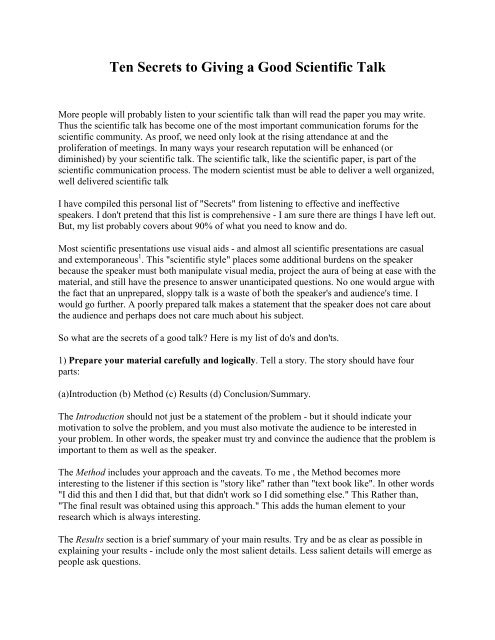

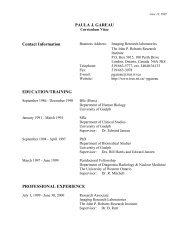

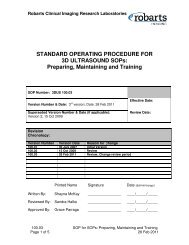
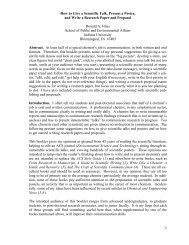
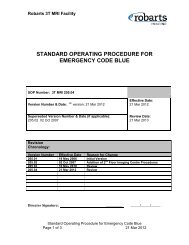


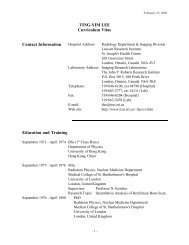

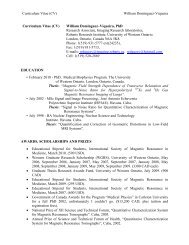

![how to read a scientific [journal] article - Robarts Imaging](https://img.yumpu.com/44345644/1/190x245/how-to-read-a-scientific-journal-article-robarts-imaging.jpg?quality=85)
